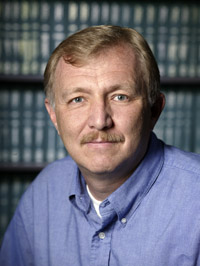Back from Banda Aceh: An Interview with Earl Wall (web article)
Earl Wall
On December 28, two days after a tsunami killed more than 100,000 people in South Asia,Earl Wall flew to Banda Aceh, Indonesia, site of some of the worst devastation and greatest loss of life. Wall is a research associate and director of development at the Center for Refugee and Disaster Response. He returned to Baltimore on January 12. Interview by Mike Field
Why did you go to Indonesia?
EW: I went representing Johns Hopkins, and in particular, the Center for Refugee and Disaster Response.
What were the conditions, in terms of delivery of medical services, when you arrived?
At the invitation of Project HOPE, I flew to Jakarta where I was met by HOPE graduates, and we took a plane to Banda Aceh, the capital of the Aceh Province and probably the hardest-hit city in the disaster. Around 50,000 people were killed in Banda Aceh.
EW: I was taken to a nearby military hospital, where my accommodations were provided, and also got to visit two other medical facilities to see what they needed. As sometimes happens in disasters of this magnitude, they had already received doctors and medical supplies in excess. There were massive quantities of medical supplies–the hallways were packed with boxes and boxes of them. What they didn’t have enough of were nurses and public health experts. And more than medical supplies, there was a critical need for temporary shelters and water purification supplies.
What did the landscape look like?
EW: There were about 400,000 people living in the Provincial capital of Banda Aceh in Northern Sumatra. In some parts of the Sumatran peninsula the mountains come right down to the sea–and in those areas the waves did not make much damage, sometimes only 20 or 30 yards inland. But most of the people lived along the river basins flowing into the sea, where the land was very flat. There the flooding went as far as 6 miles inland.
Where there were wooden buildings there would be literally nothing left–sometimes for miles on end. I heard people compare it to the devastation at Hiroshima, where there were square miles with nothing left standing. Even the palm trees were gone. In these places there were no survivors. In several places the only thing that would be left standing was the mosque. They were typically built better and were able to withstand the flooding. But there would be nothing left standing anywhere near them–just this mosque surrounded by complete devastation.
What are the challenges for Aceh and other devastated areas in the near future?
EW: It is estimated that 70 percent of the area’s doctors and nurses were either killed or fled the area. So the need to train new medical personnel will be very great. The Dr. Zinol Abdeed Hospital needs to be rehabilitated. The ground floor of the hospital was flooded by the tsunami. The building was not structurally damaged, but all of the medical equipment on the ground floor was destroyed. The building will need to be cleaned up and resupplied. Its programs need to re-established.
What dangers do the survivors face?
EW: There are a couple immediate problems: adequate shelter and clean drinking water. Right now is the rainy season and there are as many as 2 million people without homes. We know from experience that this can result in outbreaks of cholera, dysentery, malaria and other diseases, and that they can become epidemic. Also, there is a very real danger of a flu epidemic, and pneumonia is a great problem. There’s a huge relief effort underway, and none of those diseases had begun to appear two weeks after the event, so we’re hopeful.
Public Affairs media contacts for the Johns Hopkins Bloomberg School of Public Health: Tim Parsons or Kenna Lowe at 410-955-6878 or paffairs@jhsph.edu. Photographs of Earl Wall are available upon request.

